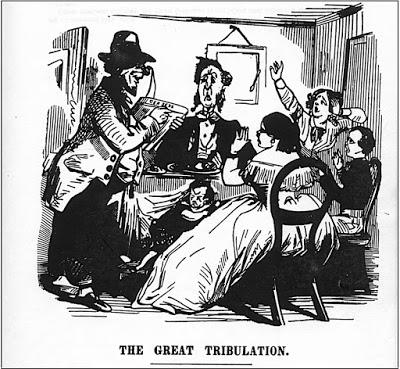
Census-taker ca. 1870; original source unknown .
It's one of those lovely June days we have here in Laramie, Wyoming. You’re out in the garden pulling weeds when a man (has to be a man) appears, introducing himself as Assistant Marshal with the U.S. Census Office. You’re not surprised—word spreads quickly in this town.He proceeds to ask a seemingly interminable series of questions, required by law, for every person in the household: name, age, sex, and color; occupation; property, bonds and other valuables; and more. Finally, is anyone illiterate? insane? a pauper?
But that was 1870. The U.S. census is no longer a Great Tribulation (from Latin ‘tribulum’—a threshing board with sharp points). The 2020 census now underway is short, easy, confidential, and, if done right, safe!
Enumerating the peopleArticle 1, Section 2, clause 3 of the U.S. Constitution (ratified in 1788) directed Congress to count the residents of the young country, to fairly apportion congressional representatives and direct taxes among the States. “The actual Enumeration shall be made within three Years after the first Meeting of the Congress of the United States, and within every subsequent Term of ten Years …”
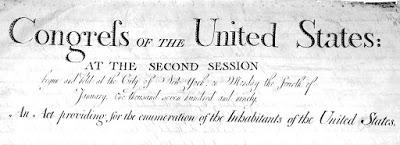
Confidentiality apparently was not an issue in 1790. Census-takers posted their results in “two of the most public places … for the inspection of all concerned.” The “aggregate amount” was sent to the President. But when George Washington read that the population of the United States was only 3.9 million, he wasn’t happy. He was sure it was larger.

Country grows, census evolvesFor the second census, some 900 enumerators counted 5.3 million residents—a 35% increase in ten years. In addition to questions asked in 1790, they recorded number of white males and females by age: under 10, 10 to 15, 16 to 24, 25 to 44 and 45 to “the utmost boundaries of life.”
Questions about manufacturing and industry were added in 1810, but dropped twenty years later due to obvious inaccuracies. They reappeared with the Census Act of 1840, which directed the Census Office to determine "the pursuits, industry, education, and resources of the country.” That year, 28 clerks processed information collected by 2167 enumerators to produce a report 1465 pages. The nation’s residents totaled 17.1 million.
The country continued to grow rapidly in area, population and number of census-takers. In 1860, 4417 enumerators counted 31.4 million residents, asking about taxes, schools, crime, wages and property values, among other things.
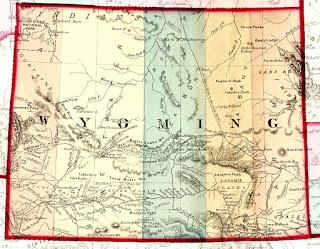
Wyoming Territory ca. 1870, with just five counties; now there are 23. Walling, Gray, Lloyd & Co. 1872, Atlas of the United States (public domain)
Counting Albany County, WyomingIn May of 1870, news of the upcoming census appeared in the Laramie Daily Sentinel. “Census-takers get two cents for every name taken, ten cents for every farm, fifteen cents for every productive establishment of industry, two cents for every deceased person, and two per cent of the whole amount for names enumerated for social statistics, and ten cents per mile for travel.” They would be paid only after they completely enumerated their area, and their forms were accepted.
The Sentinel also reported disturbing news. Even though women had the right to vote in Wyoming, they would not be not allowed to work as census-takers!
Editor James Hayford denounced the policy, with this excerpt from an Iowa newspaper: “By a recent decision of General Walker, Superintendent of the Census, the women can furnish this country with its children but are not to be permitted to count them … The old ruling that you mustn't count your chickens before they are hatched, will take on the new form that women must not count their children even after they are born.”
True confessions
Now back to the garden, on that lovely June day 150 years ago. After the census-taker introduces himself (actually, you already know him; he’s your neighbor, Walter Sinclair), he sets up his “secure portable inkstand, good ink, and pens,” and pulls out a form and blotter supplied by the Census Office.
Sinclair makes it clear that you are required by law to answer census questions, but follows the guidance of the Instructions to Assistant Marshals: “Make as little show as possible of authority. … approach every individual in a conciliatory manner; respect the prejudices of all; adapt inquiries to the comprehension of foreigners and persons of limited education; and strive in every way to relieve the performance of [your] duties from the appearance of obtrusiveness.”
He emphasizes that information will “be treated as strictly confidential” (unlike 1790). Indeed, the instructions state: “no graver offense could be committed by a census-taker than to divulge information.” Anyone suspected of such an offense will be investigated, and if found guilty, released with no pay.
There are twenty questions in all, to be asked for each member of the family. A family might be a solitary inhabitant, or the many residents of a boarding house or prison. For the purpose of the census, if people “live together under one roof, and are provided for at a common table, there is a family in the meaning of the law.”
Sinclair records name, age, sex, color, occupation, and much more, regularly drying his entries with the blotter. He uses his own judgment regarding age. “The Assistant is to obtain exact age wherever possible; otherwise, a best estimation will be made. … Where the age is a matter of considerable doubt, the Assistant Marshal may make a note to that effect.”
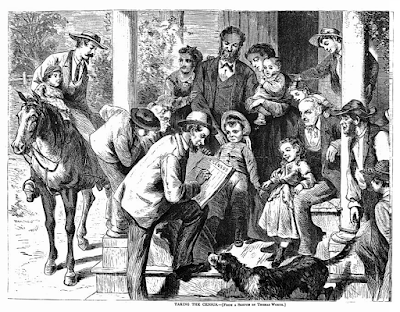
Census in a small American town; original source unknown.
The most sensitive information is addressed last. Which members of the family read? Write? Two questions are required because “Very many persons who will claim to be able to read, though they really do so in the most defective manner, will frankly admit that they cannot write.” Finally, are any members “deaf and dumb, blind, insane, or idiotic; a pauper or convict”?Sinclair then reads back the information he recorded, correcting any errors. As you return to weeding, he moves to the next dwelling. He continues as long as weather and light allow. That evening, he transcribes (by hand) two copies of the day’s completed forms, each containing information for 40 residents. In all, Sinclair filled and submitted 52 forms.
On lines 4-6 of his third form, Sinclair entered information about his own family. He and wife Anna were both 32 years of age; son Walter Kirby was 7. All three were born in Ohio, suggesting they were relatively recent arrivals to the Territory. Sinclair gave his occupation as “Ranchman” but he was better known as Deputy Sheriff of Albany County. The Daily Sentinel characterized him as an “energetic thorough officer and a terror to evil doers.” Perhaps this encouraged residents to respond promptly and honestly.
Results? Sorry, you’ll have to wait.
For the 1870 census, 6530 enumerators were able to cover the country in five months, but it took 428 clerks two years to tabulate and analyze the information. Each form had to be manually transcribed onto a grid with columns and rows representing the various types of information collected. These were then analyzed “visually.”
The final report—3473 pages of mostly tables—was published in 1872. The U.S. population was just under 39 million, ten times that of 1790. Wyoming had 9118 residents, 2021 of which lived in Albany County. The population of Laramie was 828.
The immense amount of information gathered in 1880 required seven years to process. If this trend had continued, the previous census would still be underway when the next started! But an electromechanical tabulator invented by former census employee Herman Hollerith saved the day. For the 1890 census, processing was reduced to ‘just’ six years, though the population had grown by 25% and many more questions were asked.
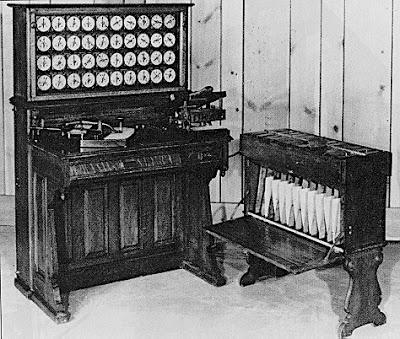
Hollerith’s 1890 tabulating machine (Columbia University/IBM).
Hit Send and be counted
Thanks to today’s information technology, the U.S. Census Bureau conducts surveys on many topics every year, including education, income, occupation, housing and emergency preparedness. But it remains best known for the decennial census, the 24th of which is currently underway.
Your household should have received by mail an “invitation” from the Census Bureau, asking you to respond in one of three ways: online (new this year), by phone, or on paper. The list of questions is short, and not all that different from 1790—number of residents; sex, age, race, relationship of each; and whether residents are of Hispanic, Latino, or Spanish origin. Because the census counts every resident, as it has since it was created, you are NOT asked whether you are a U.S. citizen (more information at 2020census.gov).
Those who don’t self-respond will have a census-taker knocking at their door. That would be a shame. Online, phone and mail are more efficient, more accurate, much cheaper, and in coronavirus times, much safer. If you haven’t already, please self-respond and be counted!

[This is my most recent contribution to the "Living History Series" in the Laramie Boomerang. We volunteer writers are providing an article a week—a bit of entertainment during coronavirus times. Also, the paper's revenue from ads has dropped significantly, with staff furloughed and content reduced. If you would like to help the "Boom" go to their website and click the Contribute button.]
